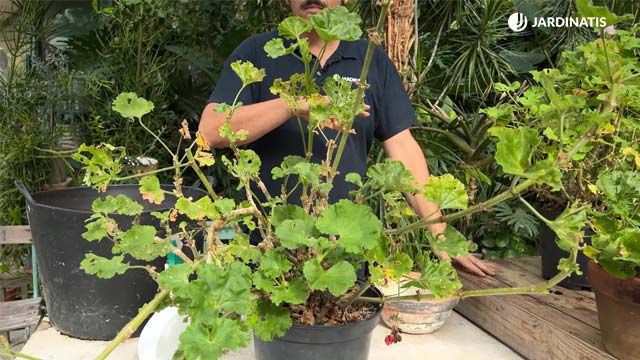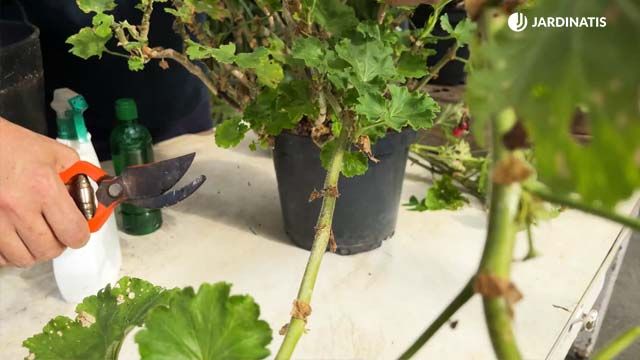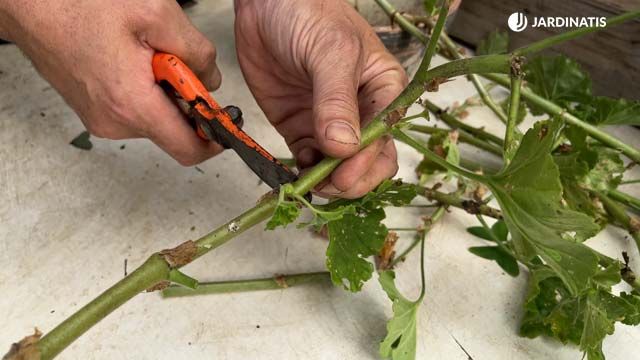Table of contents
If we want our geraniums to continue to give many flowers, in addition to good care, we must perform an annual pruning to rejuvenate the plant and prevent spiking.
When are geraniums pruned?
The best time to prune a zonal geranium or any type of geranium depends on where you live.
Although it is usually carried out in autumn, after the summer flowering period. In places where the winter is harsh and frosts occur, it is better to wait until early spring, before flowering begins.
 The perfect time to prune geraniums is when they finish flowering.
The perfect time to prune geraniums is when they finish flowering.
Autumn pruning is the best way to prepare our geraniums for the arrival of winter and that they will bloom again in the future. Every time we cut a branch, what we do is produce more branches with a greater number of flowers.
Also, every time the plants dry out, remove wilted leaves and flowers.
How to prune geraniums?
Each variety of geranium grows in a different way. There are some that are more compact, others that, although they grow more, maintain their compactness, and others that are much more ungainly. Whatever your variety is, autumn is the ideal time to prune it.
Iñigo Segurola recommends trimming all the stems that are sticking out and that have grown too much. In short, the geranium pruning consists in reducing excessive volume Once it is done, the bush should have a more or less compact appearance.
The pruning should not be radical. Do not cut the geranium completely flush as that would generate a very significant loss of leaves, reducing it by half is more than enough.
 Do not prune geraniums flush
Do not prune geraniums flush
In addition to controlling the size of the plant and its flowering, pruning is useful for the plant has more energy.
Care of geraniums after autumn pruning
Once you have pruned your varieties, they will be ready for the arrival of winter.
If you live in an area where low temperatures are constant, Iñigo recommends to place their bushes close to the balcony wall But, if the cold is excessive, place protective netting around them during these low temperatures. It is very important to protect geraniums in winter or they will eventually succumb.
Don't forget to spray the plants occasionally with treatments against the geranium butterfly, their main enemy.
What to do with shoots left over from geranium pruning?
From the pruned stems you can take cuttings to reproduce new plants. It's very easy!
First, selects all those who are healthy If you use diseased cuttings, they will not thrive.
 Cuttings with three leaf nodes
Cuttings with three leaf nodes
Next, choose cuttings with three leaf nodes You can leave some leaves, but in that case, reduce its surface area. Why is this done? Until its roots are activated, the plant has to continue to subsist. By reducing the number of leaves, transpiration will be minimal. If all the leaves were left on, there would be much more transpiration and less chance of the cuttings succeeding.
Place them in a pot with a quality substrate, a universal substrate. Cover the first knot with the substrate. Repeat the action according to the number of geranium cuttings you want to get.

To ensure success, you can optionally use rooting hormones before planting the cuttings in the substrate.
How do I know that geranium cuttings have rooted?
In the spring, we will transplant the cuttings individually, but how do we know when is the right time to do it?
You will begin to observe that the cuttings start to develop new leaves. This will be the indication that these cuttings have rooted perfectly.
As you can see, it is very easy to get new seedlings after pruning the geranium, and without spending any money! But, if you prefer, you can use another method to make geranium cuttings using toilet paper (without substrate).

